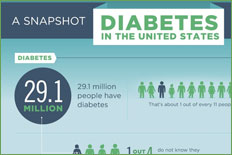Health Centers > Diabetes Center > Chronic Complications of Diabetes > Cardiovascular complications
Cardiovascular complications
1. Heart disease - Microangiopathy occurs in the heart and may explain the etiology of congestive cardiomyopathies in diabetic patients who do not have demonstrable coronary artery disease. More commonly, however, heart disease in patients with diabetes is due to coronary atherosclerosis. Myocardial infarction is three to five times more common in diabetic patients and is the leading cause of death in patients with type 2 diabetes.
Diabetes Chronic Complications
Ocular complications
L Diabetic cataracts
L Diabetic retinopathy
L Glaucoma
Diabetic Nephropathy
L Microalbuminuria
L Progressive diabetic nephropathy
Diabetic Neuropathy
L Peripheral neuropathy
L Autonomic neuropathy
Cardiovascular complications
L Heart disease
L Peripheral vascular disease
Skin and Mucous membrane complications
Special Situations
Prognosis
Cardiovascular disease risk is increased in patients with type 1 diabetes as well, although the absolute risk is lower than in patients with type 2 diabetes. Premenopausal women who normally have lower rates of coronary artery disease lose this protection once diabetes develops. The increased risk in patients with type 2 diabetes reflects the combination of hyperglycemia, hyperlipidemia, abnormalities of platelet adhesiveness, coagulation factors, hypertension, oxidative stress, and inflammation. Large intervention studies of risk factor reduction in diabetes are lacking, but it is reasonable to assume that reducing these risk factors would have a beneficial effect.
Lowering LDL cholesterol reduces first events in patients without known coronary disease and secondary events in patients with known coronary disease. These intervention studies included some patients with diabetes, and the benefits of LDL cholesterol lowering was apparent in this group. The National Cholesterol Education Program clinical practice guidelines have designated diabetes as a coronary risk equivalent and have recommended that patients with diabetes should have an LDL cholesterol goal of < 100 mg/dL.
The ADA also recommends lowering blood pressure to 130/80 mm Hg or less. The Heart Outcomes Prevention Evaluation (HOPE) study randomized 9297 high-risk patients who had evidence of vascular disease or diabetes plus one other cardiovascular risk factor to receive ramipril or placebo for a mean of 5 years.
Treatment with ramipril resulted in a 25% reduction of the risk of myocardial infarction, stroke, or death from cardiovascular disease. The mean difference between the placebo and ramipril group was 2.2 mm Hg systolic and 1.4 mm Hg diastolic blood pressure. The reduction in cardiovascular event rate remained significant after adjustment for this small difference in blood pressure. The mechanism underlying this protective effect of ramipril is unknown.
Patients with type 2 diabetes who already have cardiovascular disease or microalbuminuria should therefore be considered for treatment with an ACE inhibitor. More clinical studies are needed to address the question of whether patients with type 2 diabetes who do not have cardiovascular disease or microalbuminuria would specifically benefit from ACE inhibitor treatment.
Aspirin at a dose of 81-325 mg daily has been shown to effectively inhibit thromboxane synthesis by platelets and reduce the risk of diabetic atherothrombosis without increasing risks of gastrointestinal hemorrhage. Use of low-dose enteric-coated aspirin is recommended in diabetic adults with evident macrovascular disease or in those with increased cardiovascular risk factors or those older than 30 years. Contraindications for aspirin therapy are patients with aspirin allergy, bleeding tendency, recent gastrointestinal bleeding, or active hepatic disease.
The Hypoglycemic States
Spontaneous hypoglycemia in adults is of two principal types: fasting and postprandial. Symptoms begin ...
Diabetes Complications
The major cause of the high morbidity and mortality rate associated with...
Chronic Complications of Diabetes
Late clinical manifestations of diabetes mellitus include a number of pathologic changes ...
Diabetes Cardiovascular complications
Cardiovascular disease risk is increased in patients with type 1 diabetes...
Complications of Insulin Therapy
Hypoglycemic reactions, the most common complication of insulin therapy...
Diabetic Nephropathy
As many as 4000 cases of end-stage renal disease occur each year among diabetic people in the United States...
Diabetic Neuropathy
Diabetic neuropathies are the most common complications of diabetes affecting...
The Early Treatment Diabetic Retinopathy Study (ETDRS) showed that aspirin does not influence the course of proliferative retinopathy. There was no statistically significant difference in the severity of vitreous/preretinal hemorrhages or their rate of resolution between the aspirin and placebo groups. Thus, it appears that there is no contraindication to aspirin use to achieve cardiovascular benefit in diabetic patients who have proliferative retinopathy.
2. Peripheral vascular disease - Atherosclerosis is markedly accelerated in the larger arteries. It is often diffuse, with localized enhancement in certain areas of turbulent blood flow, such as at the bifurcation of the aorta or other large vessels. Clinical manifestations of peripheral vascular disease include ischemia of the lower extremities, impotence, and intestinal angina.
The incidence of gangrene of the feet in diabetics is 30 times that in age-matched controls. The factors responsible for its development, in addition to peripheral vascular disease, are small vessel disease, peripheral neuropathy with loss of both pain sensation and neurogenic inflammatory responses, and secondary infection. In two-thirds of patients with ischemic gangrene, pedal pulses are not palpable. In the remaining one-third who have palpable pulses, reduced blood flow through these vessels can be demonstrated by plethysmographic or Doppler ultrasound examination.
Prevention of foot injury is imperative. Agents that reduce peripheral blood flow such as tobacco and propranolol should be avoided. Control of other risk factors such as hypertension is essential. Cholesterol-lowering agents are useful as adjunctive therapy when early ischemic signs are detected and when dyslipidemia is present. Patients should be advised to seek immediate medical care if a diabetic foot ulcer develops. Improvement in peripheral blood flow with endarterectomy and bypass operations is possible in certain patients.
Daily Diabetes News
Rice study details stress-diabetes link
That control lies with the brain’s executive functions, processes that handle attention, inhibition, working memory and cognitive flexibility and are also involved in reasoning, problem-solving and planning.
The study…


